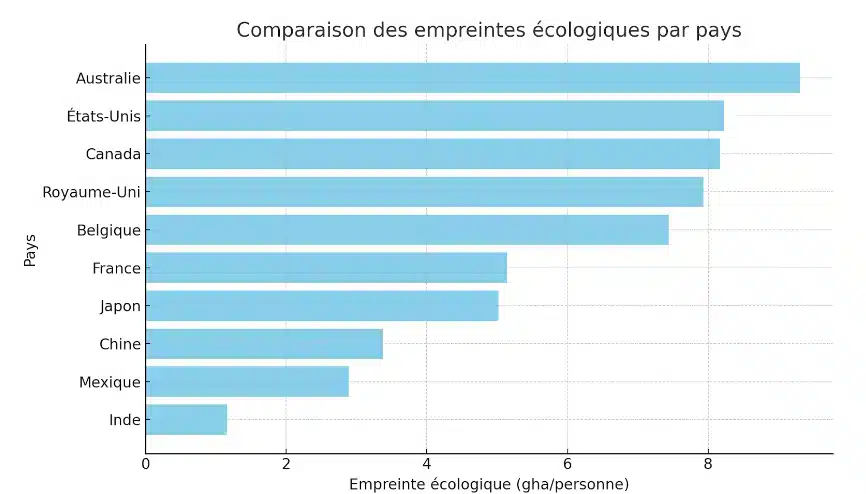How to calculate your ecological footprint?
Reading 4 min
June 18, 2025
Summary
Calculating your ecological footprint is essential to understanding and reducing your environmental impact. In this article, discover the different steps and tools available to assess your ecological footprint, so you can implement effective strategies to minimize your impact on the planet.
INDEX
% of article read

Understanding the Ecological Footprint
The ecological footprint is an indicator that measures the pressure exerted by human activities on the planet's ecosystems. It evaluates the area needed to produce the resources consumed and absorb the waste generated by a person, organization, or population. The main components of the ecological footprint include energy consumption, land use, carbon footprint (related to CO2 emissions), and waste management.
Calculating the ecological footprint allows us to quantify the environmental impact of our lifestyles and identify areas where improvements can be made. For example, by measuring the ecological footprint, it is possible to assess the sustainability of our dietary habits, transportation, and energy consumption, and implement strategies to reduce our impact on the planet.
Ecological Footprint vs. Carbon Footprint
The ecological footprint and carbon footprint are two complementary but distinct environmental indicators. The ecological footprint measures the area required to generate the resources used and assimilate the waste produced by an individual or organization.
The carbon footprint, on the other hand, focuses exclusively on greenhouse gas emissions, primarily CO2, generated by human activities. Thus, the carbon footprint is a component of the ecological footprint, specifically targeting the climatic impacts related to GHG emissions.
How to Calculate Your Ecological Footprint?
To calculate your ecological footprint, start by assessing your resource consumption and waste production in various areas such as energy, food, transportation, and consumer goods.
Several tools are available to calculate your ecological footprint. Online calculators, such as the one from WWF, offer intuitive interfaces to estimate your ecological footprint based on various lifestyle parameters.
Mobile apps are also useful for tracking and reducing your ecological footprint daily. Many apps help monitor consumption habits and adopt more sustainable practices. They offer daily challenges and personalized tips to easily reduce your ecological footprint.
Finally, specialized software, such as D-Carbonize, is available for businesses and organizations. These tools offer advanced features to calculate greenhouse gas emissions, analyze environmental data, and develop emission reduction strategies.
Your free carbon footprint awaits!
Register to your free trial, answer 20 questions and receive your carbon footprint.
Interpreting the Ecological Footprint Results
Once you have calculated your ecological footprint, interpreting the results is a crucial step to understanding the impact of your activities on the environment and identifying possible corrective measures.
First, compare your ecological footprint to the national or global average to see how you stand relative to others. For example, the global average ecological footprint per person is about 2.8 global hectares, while it can be much higher in developed countries.
Analyze the different components of your ecological footprint to determine the main sources of emissions. This may include domestic energy consumption, car travel, air travel, or the consumption of meat and processed products.
Then, consider your results to set realistic reduction goals. For example, if your ecological footprint is mainly due to energy consumption, you could aim to reduce your electricity consumption by opting for more efficient appliances or adopting renewable energy sources.
Regularly reassess your ecological footprint to track your progress. Use the same tools and methodologies to ensure consistency in the results and adjust your strategies based on observed improvements.
Tips
Use tools such as online calculators and mobile apps to measure and track your ecological footprint. This will help you identify the main sources of emissions and implement effective strategies to reduce your environmental impact.
Ecological Footprint by Country
The ecological footprint varies significantly from one country to another based on factors such as the level of development, consumption patterns, and environmental policies. The countries with the highest ecological footprints per capita are the United States (8.1 gha/person), Australia (9.3 gha/person), and Canada (8.6 gha/person). In comparison, China (3.7 gha/person) and India (1.2 gha/person) have more modest footprints. European countries have average ecological footprints, with 7.44 gha/person for Belgium and 5.14 gha/person for France.

Understanding and reducing your ecological footprint is a key step towards a more sustainable lifestyle. By using the right tools, you can easily identify the main sources of emissions and take concrete measures to reduce them, thus contributing to the protection of our planet.
